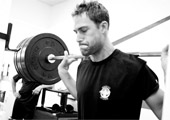 If you’re reading this, then your season is probably over. Sorry about that. You put a lot of blood, sweat, and maybe even a few tears into the season. Unfortunately, things don’t always seem to go the way you may have planned. Just don’t use it as an excuse to delay the inevitable.
If you’re reading this, then your season is probably over. Sorry about that. You put a lot of blood, sweat, and maybe even a few tears into the season. Unfortunately, things don’t always seem to go the way you may have planned. Just don’t use it as an excuse to delay the inevitable.
If you want to be better next season, YOU MUST TRAIN. When I say train, I don’t mean follow a teammate into a gym or sprint all night, like Miracle. What I mean is a fully committed, systematic approach, something sort of scientific, but basic.
It all starts with 2.5 weeks of down time. You may have hoped for more or even less, but it’s necessary. Likely, your body is recovering from a battered season. Nagging injuries stack up throughout the season, they require time to heal. If we’re talking about a severe injury, then hopefully you’ve already seen a doctor and have yourself on a track to recovery. Psychologically, you need time to heal as well. A clear mind is quicker and better at releasing those good hormones that sharpen our senses.
Two and a half weeks of YOU time. No hockey. No training. Just mental and physical recovery. Do what you enjoy outside the game. In fact, don’t even think about the game until 17 days in. Take a vacation. Do something!
After that time, you should feel refreshed. If you took my advice, you’ve already started to think about how you want to proceed into next season. What needs to change? What needs to be better? Recognize your flaws.
When I mentioned a systematic process, I was referring to change that would improve the body as one whole working unit. Let’s say you struggled to make it through a shift. I could relate that to 3 different problems that need to be addressed.
- Nutrition
- Poor energy system utilization
- Muscular imbalance
One of the quickest things to change is your diet. Cut the junk. How do you expect your body to function at 110% capacity if you’re feeding it ho-hos and candy bars? If you’re at a loss on how to eat well, then take the initiative to visit a Sports Nutritionist that can help you get your diet on track. Visit www.hockeyot.com and www.ultimatehockeysource.com for other nutritional tips.
HockeyOT.com Sports Nutrition Program
What does nutrition have to do with energy systems? Our bodies function on energy called ATP. In order to create ATP efficiently, you need proper fuel. But wait…. High octane fuel doesn’t make a Prius any faster. This is where proper energy system utilization becomes important. I would assume that if you are gasping for breath after a quick shift, then likely you have trained your energy systems ineffectively. The rigors of the season have depleted your endurance levels beyond expectations. So, you must build them back up. In fact, I suggest developing higher levels of endurance than past season, so that you can sustain those levels well into the playoffs.
We build endurance two different ways: Muscular and Cardiovascular. Muscular endurance provides us with the ability to perform a task that requires power repeated i.e. a hard shot or pass. While Cardiovascular endurance enables us to go faster longer without being totally gassed. Chances are if you’re gassed after a shift, then you need to address the cardio aspects of the game in your 1st step of training. We call that periodization.
Gauging time spent in each “period” is relatively easy. Take your worst attributes, the ones that you want to work on the most, train those first and sustain that level of fitness through the much of the off-season. Follow that up with your strongest attributes. Be cautious of overtraining. That can be a major setback. Signs of overtraining are slowed progress, increased, prolonged soreness, poor sleeping patterns and much more. If your exercise performance mechanics are affected, then muscular imbalances can occur, which is another problem you may need to address.
Correcting your diet and teaching your body how to utilize the right energy at the right time provides you with the best opportunity to gain strength, power and increase muscular efficiency. Hockey players have notorious muscular imbalances, especially in the hip complex. These imbalances lead to an increased risk of injury. Equally, a body that is inhibited lacks the ability to perform at peak performance. Maybe, your shot is weak? Are you struggling to beat the opponent to the puck in less than 3 strides?
Both of those issues have a little something to do with your muscles ability to read, react and perform. As a hockey player, you need power aka the ability to get to the puck in less than 3 strides. So we teach our athletes to train the legs and core to become more explosive via various degrees of resistance and plyometric training, the platform that produces quickness and agility. The goal, in this situation, is to make all of the muscles, involved in producing efficient power and quickness, work better together.
It may be a little difficult to see, but developing a systematic approach to the off-season ensures that each stage produces cumulative results. Sometimes admitting your flaws can be tough, especially to your Strength Coach. Fortunately, it’s our job, as Strength Coaches, to see the problems and correct them before you do. The goal is to lead the body into the next stage without hesitation, giving you the best chance to develop efficient patterns that lay the ground work for an improvement over last season.















